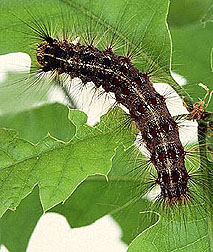This page has been archived and is being provided for reference purposes only. The page is no longer being updated, and therefore, links on the page may be invalid.
|
|
|
|
Bacterium Curbs Several Insect Pests
By Sharon DurhamMay 23, 2007
A bacterium discovered by Agricultural Research Service (ARS) scientists that is toxic to Colorado potato beetle also has been found to be toxic in varying degrees to gypsy moth, small hive beetle and tobacco hornworm.
Microbiologist Phyllis Martin, molecular biologist Dawn Gundersen-Rindal, and entomologist Michael Blackburn at the ARS Insect Biocontrol Laboratory, Beltsville, Md., and chemist Jeffrey Buyer at the Sustainable Agricultural Systems Laboratory in Beltsville found and described the new bacterial species, Chromobacterium suttsuga, now called Chromobacterium subtsugae sp. nov. The group then found that the bacterium displayed toxicity to Colorado potato beetle.
The findings are published in the May issue of the International Journal of Systematic and Evolutionary Microbiology.
Soil rich in decomposed hemlock leaves, collected from the Catoctin Mountain region in central Maryland, was the source of the new species. The team isolated the microbe by suspending samples of forest soil in water and then plating it directly on growth medium that doesn't contain glucose. Bacteria in the samples initially formed small and cream-colored colonies, which gradually turned to light-to-dark violet from the center of the colony outward.
Fifty percent of small hive beetles died within five days when fed a pollen-based diet containing the bacteria, and the survivors weighed only 10 percent as much as small hive beetles that weren't exposed to the bacteria. Tobacco hornworm and gypsy moth weren't killed by the bacteria, but their weights were drastically reduced due to feeding inhibition. Weights of tobacco hornworms that were fed the bacteria-laced diet were drastically reduced—24 milligrams for bacteria-treated insects compared to 119 milligrams for insects that didn't eat the bacteria. Gypsy moths eating the bacteria weighed 40 percent less than gypsy moths that weren't fed the bacteria.
Martin and her colleagues will work to isolate the toxin from the bacteria. Insects usually develop resistance to toxic substances, so it is important to identify new toxins.
In previous studies conducted by Martin, Chromobacterium subtsugae sp. nov. was also found to be toxic, in varying degrees, to western corn rootworm, southern corn rootworm and diamondback moth.
ARS is the U.S. Department of Agriculture's chief scientific research agency.

